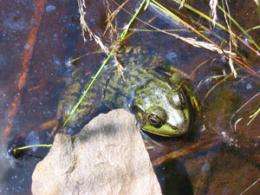Amphibians living in an old mine tailings site near Upper Seal Harbour, NS, exhibit high levels of inorganic arsenic from the contaminated area yet appear quite healthy. Dr. Iris Koch and a team of researchers from the Royal Military College of Canada, along with scientists at the Canadian Light Source, say these animals could be the canary in the coal mine for understanding arsenic levels in fresh water. Credit: Mike Parsons, Geological Survey of Canada
(Phys.org) —Amphibians living in an old mine tailings site near Upper Seal Harbour, Nova Scotia, show high levels of arsenic after being tested using synchrotron light, leading scientists to believe these animals could be the canary in the coal mine for monitoring fresh water sites and understanding health concerns with arsenic in the environment.
Groundwater arsenic contamination is an international health concern. Many countries including Bangladesh, India, Nepal, and China are dealing with widespread contamination issues in their population.
Canada is not immune to arsenic in our fresh water supply, so Dr. Iris Koch and a team of researchers from the Royal Military College of Canada (RMCC) and the Canadian Light Source (CLS) collected samples from two different species of frogs and toads, as well as water samples from the Nova Scotia site, to find out how arsenic is absorbed in the environment.
The frog samples were tested using powerful X-rays at the CLS synchrotron in Saskatoon. The results were published in the Royal Society of Chemistry journal Environmental Science: Processes & Impacts by Koch and her colleagues.
She says the results of the research show that the amphibians have very detectable levels of inorganic arsenic, a substance that is typically toxic, yet these animals appear to be relatively healthy.
"We really don't know if this is having an effect on the frogs or not," said Koch. "We know the levels of inorganic arsenic are not enough to kill them, but whether this is affecting their hormone levels is another question altogether."
The biggest outcome of the research, said Koch, is understanding arsenic movement in the environment. According to the published article, the total arsenic concentration in the frogs from the contaminated site was significantly higher than samples taken from another location not near a mine tailing site.
"At the end of the day, looking at a contaminated site like the one in Nova Scotia, we are interested in whether any of the arsenic in the soil and tailings gets into plants and animals. We can learn about what animals do with the arsenic in their bodies and this might be helpful in predicting how people might interact with the arsenic, if they were exposed to it."
Koch finds it interesting that frogs can live in an area with such high arsenic levels, and understanding how they are biologically coping will be the next step in her research. This could be key to helping human populations suffering from health-related issues due to arsenic contamination in the water supply.
"We still don't know how the arsenic is excreted or exactly how it's changed in the body, so understanding how the amphibians are coping will be the next step."
More information: Moriarty, M. et al. Arsenic species and uptake in amphibians (Rana clamitans and Bufo americanus), Environ. Sci.: Processes Impacts (2013). DOI: 10.1039/C3EM00223C
Provided by Canadian Light Source




















